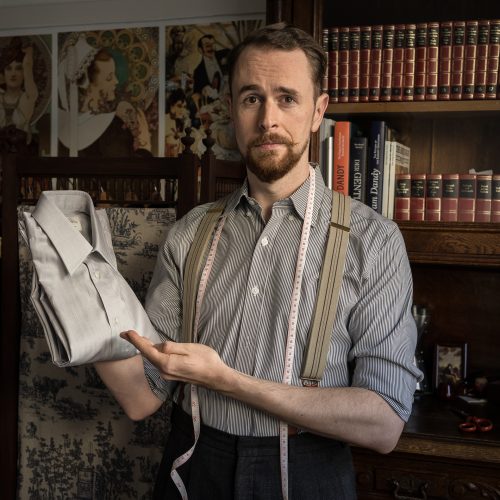Whether for everyday office life, your own wedding or stylish leisure activities: shirts are the foundation of a man’s wardrobe. They must fit well, be comfortable and hard-wearing. Made-to-measure shirts are now available on every internet street corner. They can be tailored to your own requirements and body shape. But often one is overwhelmed by the options offered by online configurators. This article is intended to help and serve as an orientation aid when putting together your own made-to-measure shirt. Let’s go!

Occasion
First of all, every new shirt designer should ask himself for which occasion the shirt should be used: office? wedding? spare time? For your own wedding usually only a white shirt is suitable. Light grey and blue tones as well as discreet striped patterns also fit into the office. In the spare time again everything is allowed what pleases. I would rather advise against all-round shirts, because you automatically have to make compromises. Three shirts for these three occasions is not too much to ask for, is it?
Choice of fabric
Let’s briefly return to the fabric of the new tailored shirt. In addition to color and pattern, the weave and material are the most important factors here. The two most common materials are cotton and linen. These perform basically similar, but linen always looks a bit more sporty than cotton due to its crease characteristics. On the other hand, linen is unbeatably comfortable to wear in summer. Ultimately, the choice of material is certainly a matter of taste.
Apart from the material, the weave is also important for the look and feel. The five most popular variations are:
- Poplin: Plain weave which, depending on the yarn, results in a very thin and fine fabric.
- Twill: These fabrics are usually not quite as fine as poplin, but are more resistant and slightly stretchy even without synthetic fibers.
- Oxford: Panama weave fabric (a kind of coarse plain weave), which is resistant and whose structure provides a great comfort.
- Chevron: Also known as herringbone. Basically a twill weave with changing directions and similar properties.
- Seersucker is mainly known as a material for bed linen. Different tensions of the warp and weft threads lead to a kind of “dent look”, which looks very sporty but also has a wonderful cooling effect in summer.

Collars
For office or wedding all turn down collars without buttons are suitable. The tab collar is a formal eye-catcher because it raises the tie knot. But you can’t wear it without a tie. No matter which collar you choose, it should be firm for more formal occasions.
The shape of the collar shanks is in my opinion one of the most important aspects of the whole shirt. Because the length and spread of the shanks should be based on the shape of your face. The longer the face, the longer the collar shanks should be. I strongly recommend not using wide spread shanks to long faces, they make the face appear even bigger/longer than it is. Regardless of this, a strong spread (also known as shark collar) is considered modern.
For casual shirts, finally, variants with buttons and very soft collar shanks are perfect. Because here, wearing comfort is the main focus.

Cuffs
For shirt cuffs, the occasion merely determines whether one should choose a variant with buttons (less formal) or a french cuff (formal) for the use with cuff links. While button cuffs are still fine in the office.
All other options are a matter of personal taste: one or two buttons next to each other, straight or round finish. Only the Viennese cuffs (a hybrid with buttons and a buttonhole for cufflinks) should be avoided. They are a sign of bad taste. Wristwatch wearers are well served with two buttons in a row to create enough space for the watch on the wrist as needed.
Fit
I generally do not recommend shirts that are cut too tight. Tight-fitting shirts are uncomfortable, restrict and wear out faster. For an especially traditional look, the fit can be particularly airy. After all, you won’t see any of that under a well-fitting waistcoat anyway. Furthermore, it is elementary that the collar closes tightly around the neck. The cuffs should not be either too tight nor too loose around your wrist.

Additional options
Finally, a few words about the other design options. Long sleeves are a must unless you are designing a Hawaiian shirt or working as a bus driver – after all, you can still roll them up in case of an occasion that requires physical labour. Many people find monograms to be kitschy, so you should either omit them or place them tone-in-tone in an inconspicuous place. Breast pockets are only needed on shirts where you do physical labor.
Purchase recommendations
I have had particularly good experiences with the purchase of made-to-measure shirts recently at Apposta. The choice of fabric and design options (long and particularly firm collar shanks!) are overwhelmingly good. The workmanship is flawless and the shirt configurator is pleasant to use.
Penny-pinchers and vintage lovers can also go on a second-hand treasure hunt instead of a custom-made shirt. Shirts that are too wide can be tailored with two darts in the back. But the collar must fit! A video on how to make a shirt for removable collars from a modern shirt can be found here on YouTube.
This article was sponsored by Apposta.





lionel 20. March 2024
Good morning
thank you for existing first of all.
then I ask you if I need a very specific application to download the electronic book.
and is this possible on a smartphone.
thank you in advance and have a good evening
Vintagebursche 21. March 2024 — Post Author
You don’t need anything specific. It’s just a PDF.